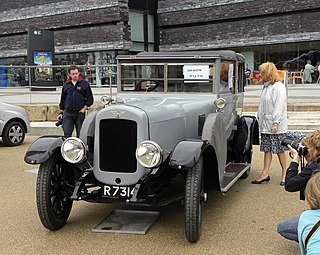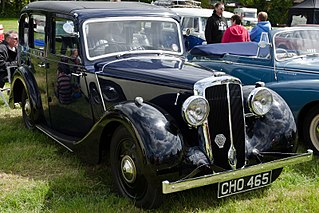Related Research Articles

The Austin Sixteen Light Six is a British car that was made by Austin from 1927. Announced in October 1927, the first deliveries were planned for March 1928.

The Sunbeam Rapier is an automobile produced by Rootes Group from 1955 until 1976, in two different body-styles, the "Series" cars and the later (1967–76) fastback shape, part of the "Arrow" range.
The Lanchester Motor Company Limited was a car manufacturer located until early 1931 at Armourer Mills, Montgomery Street, Sparkbrook, Birmingham, and afterwards at Sandy Lane, Coventry England. The marque has been unused since the last Lanchester was produced in 1955. The Lanchester Motor Company Limited is still registered as an active company and accounts are filed each year, although as of 2014 it is marked as "non-trading".

This article refers to the motor car manufactured by Morris Motors Limited from 1928–1934. For the Morris Minor manufactured by Morris Motors Limited from 1948–1971, see Morris Minor.
The Rover 8 was a small single-cylinder 8 hp 1327 cc car made by the British Rover car company. It was Rover's first production car. It was remarkable for being supported by a backbone chassis rather than a conventional ladder frame. The first model was manufactured from 1904 to 1912, A Daimler-Knight sleeve-valve engine option was available in 1911 and 1912.

The Rover 10 was a small family car from the British Rover car company produced between 1927 and 1947.

The Hillman Fourteen is a medium-sized 4-cylinder car announced by Hillman's managing director Spencer Wilks, a son-in-law of William Hillman, at the end of September 1925. This new Fourteen substantially increased Hillman's market share and remained on sale into 1931. During this time it was the main product of the company.

The Rover Light Six was a narrower lightweight short wheelbase variant of their Two-litre sports saloon produced from 1929 to 1930 by the Rover Company of Coventry. The following season it was sold with a 2½-litre 20 hp engine under the name Rover Light Twenty.

The Rover 12 was a name given to several medium-sized family cars from the British Rover car company between 1905 and 1948.

The Vauxhall 30–98 is a car manufactured by Vauxhall at Luton, Bedfordshire from 1913 to 1927. In its day, its best-known configuration was the Vauxhall Velox standard 4-seater with open tourer body. Vauxhall's own description was the 30–98 hp Vauxhall-Velox sporting car. The 30–98 is also known to enthusiasts by Vauxhall's chassis code E.

Austin Twenty is a large car introduced by Austin after the end of the First World War, in April 1919 and continued in production until 1930. After the Austin 20/6 model was introduced in 1927, the first model was referred to as the Austin 20/4.

The Talbot 14-45 also known as Talbot 65 is a luxury car designed by Georges Roesch and made by Clément Talbot Limited in their North Kensington factory and usually bodied by fellow subsidiary of S T D Limited, Darracq Motor Engineering in Fulham.

Morris Oxford Series MO is an automobile produced by Morris Motors of the United Kingdom from 1948 to 1954. It was one of several models to carry the Morris Oxford name between 1913 and 1971.

The Lanchester Fourteen Roadrider is a six-cylinder automobile introduced by the Lanchester Motor Company in the beginning of September 1936. It was named "Roadrider" for its special suspension features, and billed as the lowest-priced six-cylinder Lanchester ever offered. This car replaced the previous 12 hp Light Six model with a larger six-cylinder engine again in the Lanchester Eleven chassis and body.

The Vauxhall 23-60 is a four or five-seater touring car manufactured by Vauxhall of Luton that was announced in July 1922. The 23-60's standard tourer Kington body was described as "preserving that greyhound look so characteristic of the Vauxhall car". It shared many parts with Vauxhall's much more powerful 30-98.

The Vauxhall 20-60 is a four or five-seater saloon, limousine, tourer or coupé-cabriolet manufactured by Vauxhall of Luton. It was announced on 28 September 1927 with a six-cylinder engine and a four-speed gearbox. A cautious move downmarket. "The first time any six-cylinder Vauxhall has been sold under £1000!" "British & Vauxhall". The initial 2.7-litre engine was enlarged to 3-litres after twelve months.

The Morris Six is a 2½-litre six-cylinder car with an overhead camshaft for its overhead valves first displayed at the October 1927 Motor Show at Olympia as Morris Light Six. When he bought Wolseley in February 1927 W R Morris gave Wolseley employees his reason. It was that he wanted to make good 6-cylinder cars and Wolseley could do that. He said he particularly admired their 2-litre Wolseley 16/45.
Morris Oxford is a series of motor car models produced by Morris Motors of the United Kingdom, from the 1913 bullnose Oxford to the Farina Oxfords V and VI.

The Morris Oxford Six is a motor car produced by Morris of the United Kingdom from 1921 until 1926, and again from 1929 until 1935. Initially produced as a straight-six engined version of the Morris Oxford bullnose, the original Oxford Six was the first car produced by Morris with a six-cylinder engine, but proved to be unreliable. The versions produced from 1929 onwards were introduced as a replacement for the Morris Oxford 16/40.
References
- 1 2 3 4 5 6 7 8 9 Cars Of 1929. The Times, Thursday, Oct 04, 1928; pg. 8; Issue 45015
- 1 2 3 4 5 6 7 8 9 10 11 12 13 14 15 16 17 18 19 20 Cars Of To-Day. The Times, Tuesday, May 28, 1929; pg. 22; Issue 45214
- 1 2 3 4 Motor Show. The Times, Monday, Oct 15, 1928; pg. 24; Issue 45024
- 1 2 3 Culshaw and Horrobin (1974). Complete Catalogue of British Cars London: Macmillan. ISBN 0-333-16689-2.
- 1 2 Cars Of To-Day. The Times, Tuesday, Oct 13, 1931; pg. 6; Issue 45952
- ↑ Michael Sedgwick and Helen Marshall, Cars of the 1930s, Batsford, London, 1970 ISBN 0713404655 OCLC 471164043
- ↑ Motor-Cars For 1929. The Times, Friday, Sep 07, 1928; pg. 9; Issue 44992
- ↑ p.61, Michael Sedgwick, Cars of the Thirties and Forties, Hamlyn, London 1975 ISBN 0600321487
- ↑ p.30, Michael Sedgwick, Cars of the Thirties and Forties, Hamlin, London 1975 ISBN 0600321487
- 1 2 3 Cars Of To-Day. The Times, Tuesday, Oct 14, 1930; pg. 8; Issue 45643